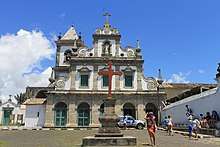Convent and Church of Saint Anthony (Cairu)
The Church and Convent of Saint Antony (Portuguese: Igreja e Convento de Santo António) is a 17th-century Roman Catholic church located in Cairu, Bahia, Brazil. It was consecrated in 1650, but construction on the complex probably began at the beginning of the century. The church building is noted for its elaborate façade and numerous Franciscan architectural elements. It covers 3,215 square metres (34,610 sq ft). The church was listed as a historic structure by the National Historic and Artistic Heritage Institute in 1941. The architect Mário Mendonça de Oliveira calls the convent and church "one of the most outstanding existing examples of Brazilian religious architecture and Franciscan architecture."[1][2][3]
| Church and Convent of Saint Antony | |
|---|---|
Igreja e Convento de Santo António | |
 Façade of the Church and Convent of Saint Antony | |
| Religion | |
| Affiliation | Catholic |
| Rite | Roman |
| Location | |
| Municipality | Cairu |
| State | Bahia |
| Country | Brazil |
 Location of the Church and Convent of Saint Antony in Brazil | |
| Geographic coordinates | 13.48681°S 39.04511°W |
| Architecture | |
| Type | Baroque |
| Date established | 1650 |
| Interior area | 3,215 square metres (34,610 sq ft) |
National Historic Heritage of Brazil | |
| Designated | 1941 |
| Reference no. | 258 |
History
The Convent and Church of Saint Antony of Cairu was built on the site of a small chapel, also named after Saint Antony. It was built by Daniel de São Francisco, a Franciscan friar born in Penafiel, Portugal. He arrived in Brazil, initially in Pernambuco, early in the 17th century. He became a friar in the Franciscan convent at Olinda, and moved to Salvador in 1630 during the Dutch occupation of Brazil. Daniel de São Francisco taught theology in Salvador for many years, and was then chosen to negotiate the separation of the Brazilian Franciscan convents from those in Portugal. He negotiated first with the Portuguese crown, then with the Pope in 1647; the first Brazilian Franciscan province was established in 1657.[1][4]
A cornerstone of the church dates to 1654, and construction was financed by both the Franciscans and donors in Bahia. Its design likely influence the Convent and Church of Saint Antony in Iguape, Cachoeira, which was completed by 1680.[1][4]
References
- Oliveira, Mário Mendonça de (2013). "Church and Convent of Saint Antony". Lisbon, Portugal: Heritage of Portuguese Influence/Património de Influência Portuguesa. Retrieved 2020-08-06.
- Secretaria da Indústria, Comércio e Turismo (Bahia, Brazil) (1997). IPAC-BA: inventário de proteção do acervo cultural. 5 (1 ed.). Salvador, Brazil: Secretaria da Indústria e Comércio. pp. 33–34.CS1 maint: multiple names: authors list (link)
- "Convento e Igreja de Santo Antônio" (in Portuguese). Salvador, Brazil: Sistema de Informações do Patrimônio Cultural da Bahia (SIPAC). 2020. Retrieved 2020-08-06.
- Sousa, Alberto (2006). "Igreja franciscana de Cairu: a invenção do barroco brasileiro". Arquitextos. 6. Retrieved 2020-08-07.
| Wikimedia Commons has media related to Convent of Saint Anthony (Cairu). |